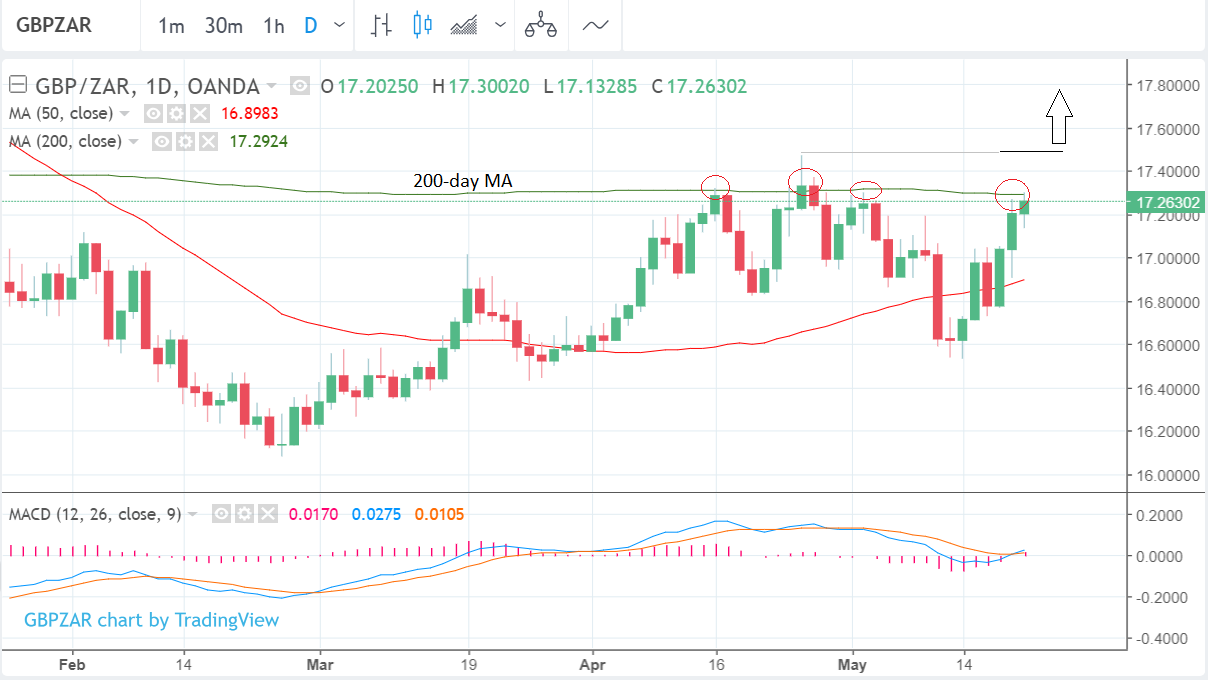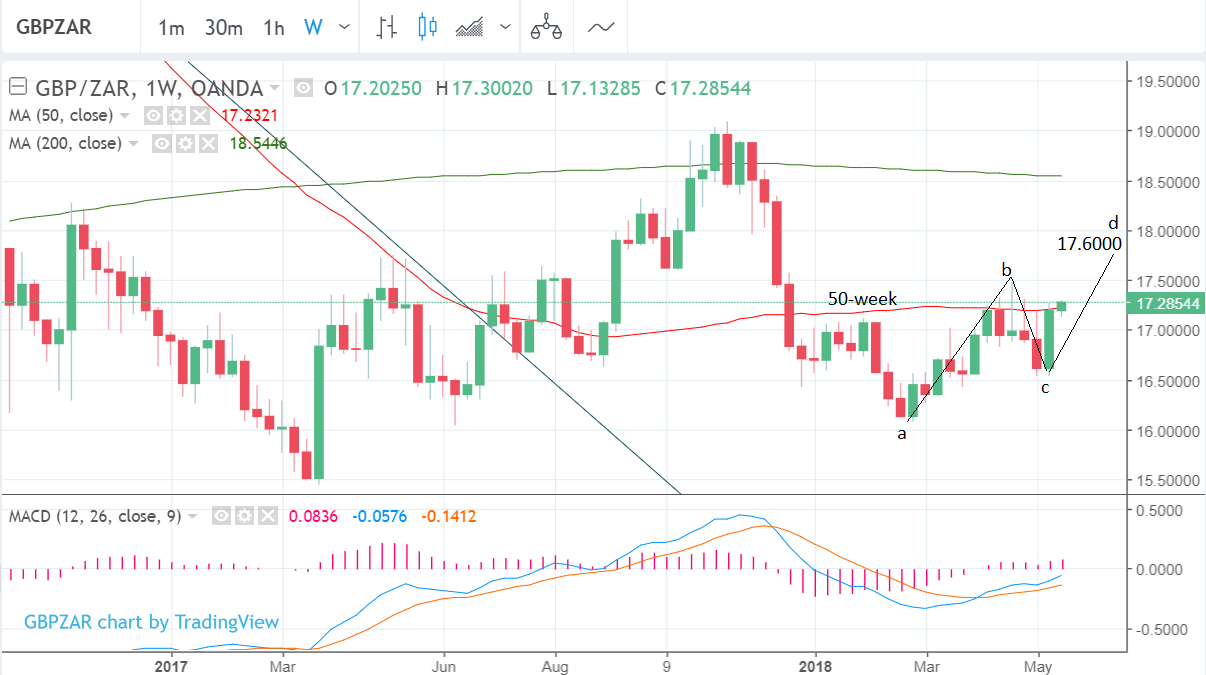Pound-Rand Forecast For the Week Ahead: Gains Capped
- GBP/ZAR has risen up to a key level where the 200-day is capping further gains
- The key release for the Pound this week is inflation data on Wednesday and retail sales data on Thursday
- For the Rand, the main event is the meeting of the central bank also on Thursday

© moonrise, Adobe Stock
The Pound-to-Rand rate made an impressive and surprising recovery last week in which it bottomed in the 16.50s before recovering back up into the 17.00s, to find itself trading at 17.26 at the moment, at the time of writing.
The exchange rate's recovery probably has more to do with Rand weakness than Sterling strength, due to the Rand's sensitivity to the US Dollar, to which it is highly negatively correlated. Last week coincided with a period of Dollar strength which weighed on the Rand. This is because a relatively high proportion of South African companies have debts denominated in Dollars so when the Dollar rises their repayments become more expensive.
The pair has now reached an interesting level on the charts where it is butting up against a familiar barrier in the form of the 200-day moving average.
In the past, the pair has repeatedly risen to touch the 200-day and been rejected, as highlighted by the red circles on the chart below. This is the fourth time; will it be different?
Technical analysis holds that repeated efforts to break above a level often, eventually succeed. The problem is forecasting when the break will happen and then trying to distinguish between a false and a true breakout.
Note, for example, the convincing-looking break higher on the 25th of April (the 2nd attempt) which saw the exchange rate rise quite far above the 200-day only to then capitulate and fall back down below it - a prime example of a false breakout.
One way traders use to get around the problem of trying to determine whether a breakout is true or false is to wait for the exchange rate to pull back to the original resistance level after the breakout has occurred, before entering a long position. The technique is based on the tendency for prices to retract temporarily to the just-broken level immediately after breaking through it. The method ensures that even if the breakout is false the trader does not stand to lose much money.
In the example of GBP/ZAR, the situation is complicated by the false break which occurred on April 25 and peaked at 17.47, because it raises the question as to where the top of the range actually is now - is it at the level of the 200-day (MA) at 17.29, or the April 25 peak?
Ultimately there is no way of telling, and either could be valid, but the trader who wants to be on the ultra-safe side should opt for the higher level.
The next question is how much higher is the exchange rate likely to go if it successfully break's out?
One aid in answering this question would be to see the move up from the February lows as an incomplete abcd pattern with the final c-d leg currently in the process of unfolding to the upside.
Assuming we are correct in identifying the current move as an abcd pattern the length of c-d should not be much different to a-b, which indicates the move up is likely to reach at least as far as a target at 17.60.
Get up to 5% more foreign exchange by using a specialist provider to get closer to the real market rate and avoid the gaping spreads charged by your bank when providing currency. Learn more here.
ZAR: What to Watch
The most important fundamental driver for the SA Rand is still the US Dollar, with domestic factors normally taking a back-seat, unless, they represent major economic changes or involve heightened political risk.
Yet this week the Rand may be influenced as much by domestic factors as foreign, as the Reserve Bank of South Africa (SARB) is scheduled to meet to decide interest rates at 14.00 GMT, on Thursday, May 25.
If the RBNZ lifts the interest rate it would result in a stronger Rand as it would attract greater inflows of foreign capital drawn by the promise of higher returns.
The outlook is increasingly suggesting an increased potential for higher rates in the future - although no-one expects a rate hike as soon as this week.
"Up ahead this week, we have local CPI and an MPC meeting, which will keep investors trading cautiously today. With a higher oil price, a weaker rand and an above-inflation pay raise for civil servants, we can expect inflation fears to start building again," says Michelle Wohlberg, an analyst at Rand Merchant Bank (RMB).
If anything, analysts had previously expected the SARB to lower rates, but the recent macro and domestic changes have turned the tables on these expectations.
"The market is indeed no longer pricing in any cuts this year," says Zaakirah Ismail, an analyst at Standard Bank, adding, "and has become noticeably more hawkish in the wake of the latest global market movements."
Whilst no-one foresees a rate hike on Thursday the SARB's official statement as well as commentary from the governor Lesetja Kganyago in the press conference after, may yet impact on the currency.
If the SARB or Kganyago, for example, states that they are now more likely to raise interest rates rather than lower them, that will probably have a positive impact on the Rand.
GBP: What to Watch
It's a busy week ahead for Sterling traders, with a welter of economic releases due for the Pound.
Inflation data, out at 9.30 on Wednesday, forms the main data event with traders looking to see whether prices are moving in a direction consistent with further interest rate rises at the Bank of England. Over recent months we have seen the Pound become increasingly attuned to Bank of England interest rate expectations; moving higher when expectations for a rate rise increase, and moving lower when those expectations are rowed back.
We recently reported that economists at Capital Economics are expecting two interest rate rises in 2018 which would present a highly bullish outcome for Sterling, but the data will have to start moving in the right direction very soon for this assumption to prove correct.
And of course, the Bank of England is watching the data and will only move on rates once they have evidence the economy is picking up the pace once more.
"UK inflation figures from April will be closely watched by markets and influence the pricing of Bank of England," says Andreas Steno Larsen, a strategist at Nordea Bank.
Inflation is expected to fall to 2.1% from 2.3% as base effects from the weak Pound start to fall away.
"As for April there is a clear risk of a rather low result due to base effects," adds Larsen.
Analysts at Investec are more bullish about inflation in April:
"We expect to see inflation tick up to 2.6% from 2.5%, albeit with the April rise likely to be a blip on a path in which we see inflation moderating," says Investec economist Victoria Clarke.
Global oil prices have been on the rise, and we would expect this to perhaps deliver an upside surprise. However, the core CPI release will, therefore, be crucial as it strips out the likes of external one-offs like oil, and the Bank of England uses the number as a proxy for underlying wage growth. In short, a beat on the core CPI would likely help Sterling higher, core is forecast to read at 0.5%.
In other UK releases, retail sales figures due Thursday morning will also be closely watched amidst concerns about UK growth (and consumer spending) momentum.
The BRC’s April figures were particularly weak, with the timing of Easter a depressing factor; we suspect the ONS’s Easter timing adjusted numbers will not look quite so gloomy.
The second estimate for UK GDP growth is due at the end of the week where Clarke suspects we will see an unrevised reading of +0.1% print. A beat would however likely boost Sterling.
Right at the beginning of the week, we get some second-tier numbers with public sector finances released at 9.30, they are expected to show government borrowing fall by 7.0bn in April. Recent public sector data has been positive on the whole so a further fall in borrowing would be seen as a positive for the economy, although a surprise reading, either way, would probably be necessary to move the Pound.
The Consortium of British Industry will also be releasing two reports for the month of May: the CBI Industrial Trends survey at 11.00 GMT on Monday and the Distributive Trades survey at the same time on Wednesday. Both will provide the most up-to-date information on economic activity in the UK and could, because of their timeliness, impact on Sterling.
Get up to 5% more foreign exchange by using a specialist provider to get closer to the real market rate and avoid the gaping spreads charged by your bank when providing currency. Learn more here.






